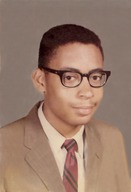
|

|
|
|
|
Asriel was born in Ruston, Louisiana to Claude and Mildred McLain. His father was a pastor and also taught school in Jackson Parish later time pastoring two churches full time. In 1959, he became the pastor at Little Union in Shreveport. His mother was a teacher and stayed in Ruston to teach at Lincoln Elementary, retiring in 1972. He grew up in Washington Heights in Ruston, where African American professionals lived. Everyone who lived there was considered to have a high social status. His father lived in the parsonage in Lakeside Allendale and was the president of the NAACP in the late 1950's. Because two men tried to bomb their Shreveport house, the house is listed as one of the Civil Rights sites. Asriel's grandfather was an entrepreneur, had stock in a bank, a store, two cars he used as a shuttle service and 600 acres of land. When he was murdered in Choudrant, Louisiana in 1919, his widow lost pretty much everything but Claude worked over the years trying to reclaim what he could. During the Depression Claude road a freight train to Tuskegee and George Washington Carver got him a job milking cows and selling manure for a dollar a load. Asriel knows that his family tree goes back to two brothers in the Ruston-Monroe area, who were devout Methodists. The Mays family had bought three slaves, two sisters and a brother. His great, great grandmother, Phyllis, was a house worker for one brother and Ned and Sophie were purchased by the other brother. The Mays gave land for the CME Church and the Mays Chapel is named for them as well as the Mays Chapel cemetery. His grandmother married twice and had two children by the first marriage and eight or nine children by her second husband, Oliver, who was a preacher. She worked as a domestic worker at Louisiana Tech and then became a cook there. In the 1930's, his mother worked for awhile as a maid for a renowned family in Ruston, the Cup family, who owned Cups Drugstore. Mrs. Cup loaned books to his mother, who was an avid reader, and got her a scholarship to go to Leland CollegeAs a child, he did play with white children. He says that small children do not see color. Prejudice is taught by the parents and grandparents and by the time he went to high school at Ruston High in 1967 desegregation was just beginning. About ten to fifteen black students attended and it was a hostile time. It was especially hard when Martin Luther King was killed. There were many challenges for him at school and only one time did he think of quitting. He had "bull tenacity" and a strong faith to help him. By the time he saw classmates 30 and 40 years later, many apologized to him. He credits attending a white high school, a black college and Princeton with giving him the ability to dialog with anybody, to understand how both cultures think, and to learn that both ethnic groups have similar concerns. Asriel's book Golden Anniversary of Civil Rights in North Louisiana, recounts his journey through the civil rights activities from the time he was ten years old. He hopes that he can be a mentor and a legacy for succeeding generations. |


